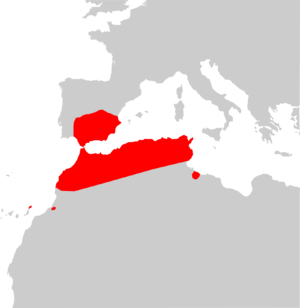Meridional serotine facts for kids
The meridional serotine (Eptesicus isabellinus) is a type of bat found in countries like Spain, Portugal, Morocco, Algeria, Tunisia, and Libya. It's a small bat known for its yellowish-brown fur.
Quick facts for kids Meridional serotine |
|
|---|---|
 |
|
| Conservation status | |
| Scientific classification | |
| Genus: |
Eptesicus
|
| Species: |
isabellinus
|
 |
|
| Range of the meridional serotine | |
| Synonyms | |
|
|
Contents
About the Meridional Serotine Bat
How it Got its Name
The meridional serotine bat was first described in 1840 by a Dutch scientist named Coenraad Jacob Temminck. He gave it the name Vespertilio isabellinus.
For a long time, scientists thought this bat was just a type of another bat, the serotine bat. They called it Eptesicus serotinus isabellinus. But in 2006, new studies looked at the bats' DNA. These studies showed that the meridional serotine was actually its own unique species. So, its original name, Eptesicus isabellinus, was brought back.
The word isabellinus means "pale yellow" in Latin. Temminck chose this name because he thought the bat's fur was a "beautiful shade of isabella," which is a pale yellowish color.
What it Looks Like
The meridional serotine bat has a forearm about 51 mm (2.0 in) long. Its back feet are about 11.6–11.8 mm (0.46–0.46 in) long.
It has long, soft fur on its back, with individual hairs about 8 mm (0.31 in) long. The fur on its belly is a bit shorter, around 6 mm (0.24 in) long. You can tell it apart from the closely related serotine bat because its fur is a lighter, yellowish-brown color. Its ears are rounded at the tip, and its feet are large with brown claws and hairy toes.
What it Eats
This bat is an insectivore, which means it eats insects. Its favorite foods include beetles, moths, and flies. It especially likes to eat scarab beetles and different kinds of flies.
Reproduction and Life Cycle
Female meridional serotine bats gather together to form special groups called maternity colonies. These colonies can have anywhere from 20 to 100 bats. They use these colonies to raise their young.
Where it Lives and Roosts
The meridional serotine bat lives in several countries. These include Spain, Portugal, Gibraltar, Morocco, Algeria, Tunisia, and Libya. It has not been found in areas higher than 1,800 m (5,900 ft) (about 5,900 feet).
During the day, these bats like to rest in safe places. They often choose rock cracks, under bridges, or inside buildings. They can live in many different types of places, from dry areas like semi-deserts to temperate forests and even suburbs. They prefer to hunt for food in open areas like pastures and gardens.
Conservation Status
The IUCN currently lists the meridional serotine bat as a species of least concern. This means that its population is stable and not currently at risk of disappearing. In some parts of southern Spain, it is even one of the most common types of bats.


